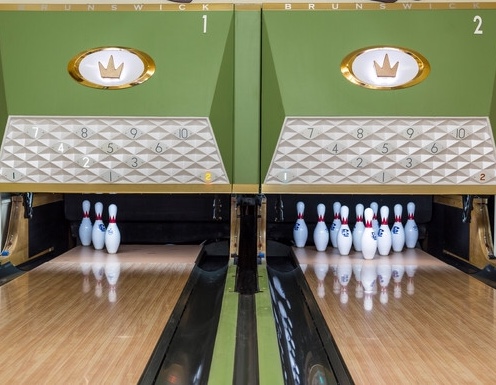
“The Brunswick”
My bowling game has its ups and downs. The last time I visited my local alley, I did something incredible and unusual for me; I bowled two strikes in a row. This feat was followed up by a move not so unusual for me—a gutter ball. Not only is this occurrence over-the-top embarrassing, but when you factor in the intricacy regarding how to score the game, this fail yields the worst possible outcome. It’s a missed, one-time opportunity to add a significant amount of points backward. But it’s also a testament to the wide swings—the sharp peaks and valleys—for the occasional, just-in-it-for-kicks, “fun times with fam and friends” bowler like me.
During the middle of the last century, the Brunswick Corporation, the leading manufacturer of bowling equipment, experienced those same peaks and valleys. In the 1950s—following the wave of post-war optimism—bowling centers sprung up everywhere. This expansion played off a strong economy, improved leisure time, suburbanization, and the introduction of the automatic pinsetter. Between 1955 and 1965, the number of bowling alleys nearly doubled, from 6,600 to 12,000. Considering they’d been producing bowling equipment for taverns since the 1880s, perhaps it was finally Brunswick’s time to shine. To rule. To firmly affix their crown on the leisure industry.

1950’s Brunswick lanes featuring their sharp, modern logo crown
This entertainment explosion neatly coincided with the mid-century modern design and architectural escalation. The Brunswick company had the keen business sense to marry these two trends, crafting bowling alleys with clean, streamlined, brightly colored plastic and metal seating, scoring tables, ball returns, and pin-setter facings. Their fortitude took the aesthetic one step further, styling the iconic Brunswick crown logo on their products with crisp angles and perfect symmetry, in shiny metallic and bright mid-century palettes. According to their 1960s advertising film, graduated shades of coral, gold, green, blue, white, and tangerine could be mixed in any combination to create a proper atmosphere for recreation.
But—in complete correlation with my bowling game and the iconic Brunswick crown—subsequent to the steep inclining trend of bowling alleys popping up, there was a decline. After about ten years of rapid suburbanization, planners and investors had simply overbuilt. The market was saturated, and the urban bowling centers began to close because fewer people were there to bowl—folks had flocked to the suburbs. So, the number of open alleys actually began to shrink. Although Brunswick lanes will probably continue to be around for a long time, their heyday peak will forever be sharply planted in mid-century modern flavors, styles, and lines.
When I first saw this Arvin metal lawn chair, its perforated back and seat formation resonated with me as crowns. I saw the chair as a princess. But as I applied bright, mid-century paint colors, it felt more like a bowling alley, the chair’s back “crown” so similar to the crisp, 1950’s and 60’s Brunswick crown. I was no longer going to a ball—I was taking my ball and hitting the lanes!
* * *

Name: The Brunswick
Artistic Restoration: Fall 2017
Manufacturer: Arvin
Period: 1950s

The artist, the chair
A shout out to Don Storer at Midcenturymetalchairs.com for his ongoing research assistance.
Continue to follow The Metal Lawn Chair of the Month at AVintageChick.com
C R Kennedy
Leave a Reply